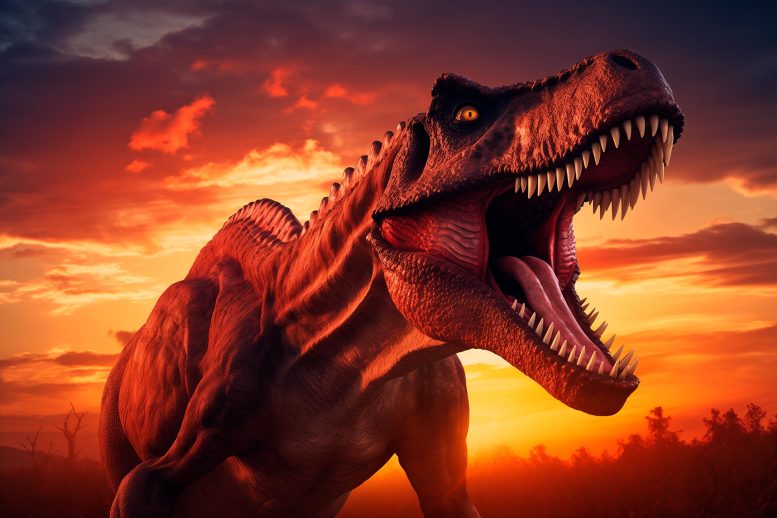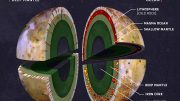
Recent research suggests that volcanic eruptions, causing global cooling, significantly contributed to the dinosaurs’ extinction, challenging the long-held belief that a meteorite was the sole cause. Credit: SciTechDaily.com
McGill researchers challenge the current understanding of dinosaur extinction by unearthing a link between volcanic eruptions and climate change.
What wiped out the dinosaurs? A meteorite plummeting to Earth is only part of the story, a new study suggests. Climate change triggered by massive volcanic eruptions may have ultimately set the stage for the dinosaur extinction, challenging the traditional narrative that a meteorite alone delivered the final blow to the ancient giants.
That’s according to a study published recently in Science Advances, co-authored by Don Baker, a professor in McGill University’s Department of Earth and Planetary Sciences.
The research team delved into volcanic eruptions of the Deccan Traps—a vast and rugged plateau in Western India formed by molten lava. Erupting a staggering one million cubic kilometers of rock, it may have played a key role in cooling the global climate around 65 million years ago.
The work took researchers around the world, from hammering out rocks in the Deccan Traps to analyzing the samples in England and Sweden.
Volcanic Winters and Dinosaur Extinction
In the lab, the scientists estimated how much sulfur and fluorine were injected into the atmosphere by massive volcanic eruptions in the 200,000 years before the dinosaur extinction.
Remarkably, they found the sulfur release could have triggered a global drop in temperature around the world—a phenomenon known as a volcanic winter.
“Our research demonstrates that climatic conditions were almost certainly unstable, with repeated volcanic winters that could have lasted decades, prior to the extinction of the dinosaurs. This instability would have made life difficult for all plants and animals and set the stage for the dinosaur extinction event. Thus our work helps explain this significant extinction event that led to the rise of mammals and the evolution of our species,” said Prof. Don Baker.
Innovative Research Techniques
Uncovering clues within ancient rock samples was no small feat. In fact, a new technique developed at McGill helped decode the volcanic history.
The technique for estimating sulfur and fluorine releases–a complex combination of chemistry and experiments–is a bit like cooking pasta.
“Imagine making pasta at home. You boil the water, add salt, and then the pasta. Some of the salt from the water goes into the pasta, but not much of it,” explains Baker.
Similarly, some elements become trapped in minerals as they cool following a volcanic eruption. Just as you could calculate salt concentrations in the water that cooked the pasta from analyzing salt in the pasta itself, the new technique allowed scientists to measure sulfur and fluorine in rock samples. With this information, the scientists could calculate the amount of these gases released during the eruptions.
The study involved researchers from Italy, Norway, Sweden, the UK, the United States and Canada.
Their findings mark a step forward in piecing together Earth’s ancient secrets and pave the way for a more informed approach to our own changing climate.
Reference: “Recurring volcanic winters during the latest Cretaceous: Sulfur and fluorine budgets of Deccan Traps lavas” by Sara Callegaro, Don R. Baker, Paul R. Renne, Leone Melluso, Kalotina Geraki, Martin J. Whitehouse, Angelo De Min and Andrea Marzoli, 4 October 2023, Science Advances.
DOI: 10.1126/sciadv.adg8284









It’s a more reasonable & closer reason for dinosaur extinction, as climate change crisis today may cause extinction of the existing life on Earth gradually, the same way it might have caused dinosaur extinction millions of years ago due to volcanic eruptions & release of dusty gasses into the atmosphere, causing gradual cold temperature on the planet. This is also a climate change alert for humans.
“…, as climate change crisis today may cause extinction of the existing life on Earth gradually, …”
If the environment changes slowly enough, evolution will allow most of the existing species to adapt and eventually become something different. If it doesn’t happen slowly, then there will be a mass extinction. At the conclusion of the mass extinction, the remaining survivors will evolve to fill the vacant ecological niches, creating new species in the process. The end result may be different in the details, but the same overall as convergent evolution optimizes the fits to the environment. If the dinosaurs hadn’t become extinct, mammals would probably have not become dominant and humans probably wouldn’t have come to be. Why is there so much fear about extinctions?
How is this new? I mean, we already knew some of them where killed on the impact, some of the blow and heat of the impact, some by the giant tsunami that was created, some by the rain of fire of the different rocks falling back in the atmosphere, and some by the cold created by the clouds shading the world from the sun.
It’s simple to imagine the smallest grain of sand (Chixulub Asteroid), hitting a bowling ball. But it’s harder to imagine the damage it caused…compared to the Deccan Traps, and perhaps the Shiva impact. I don’t think the science is quite all settled.